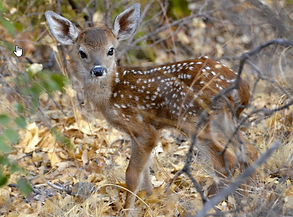
Found a Fawn, What do I do?

Deer fawns and elk calves are often born in June, which is why you may find one during your outdoor adventures in early summer. If you do happen to see one in the wild, you probably won't see its mother. Not seeing its mother might lead you to believe that the animal has been abandoned, but that is rarely the case.
Newborn fawns are actually alone and isolated during their first weeks of life, and that's on purpose. The mother knows that leaving the fawn alone is the best way to protect it from predators.
During the day, a doe deer will reunite with its fawn for a short time, to nurse it and care for it. Then, to draw attention away from where the fawn is hiding, the mother will leave the fawn. The doe will spend the rest of the day feeding and resting.
Fawns are born with a creamy brown coat that's covered with white spots. This camouflaged coat allows the fawn to blend in with its surroundings. Fawns also don't give off much scent, so it's difficult for predators to smell them.
Hiding is the best way for fawns to stay safe right after they are born. Then, after two or three weeks, the fawn grows strong enough to start accompanying its mother.
Things to know when you find a Deer Fawn or Elk Calf


What to do if you see a deer fawn or elk calf that appears to be alone:
-
Don't approach it. Watch it or take a photo of it from a distance, but don't go near it. In almost every case, the young animal has not been abandoned by its mother.
-
Don't touch it or pet it. Finding and petting newly born animals is a problem because the animal's survival depends on it being left alone. If you touch it, you may leave your scent on the animal, which could draw predators to it.
-
Give it plenty of space. Even if you don't touch the fawn or calf, getting too close can cause it to run away from you, resulting in the animal using energy it needs to survive.
-
Never attempt to remove a fawn or calf from the wild or take it home. DWR conservation officers occasionally respond to instances where an individual has taken a baby deer or elk home to "care for it." However, that often has fatal consequences for the animal and can also create public safety risks as the animal matures. It is illegal to keep wildlife in captivity and can result in a class A misdemeanor. If you believe that a baby animal is injured or sick, report it to the nearest DWR office.
-
"Keeping your distance and not touching wildlife are the keys to keeping young animals alive," Jones said. "Attempting to take matters into your own hands and trying to 'help' wildlife usually does more harm than good. Help wildlife by allowing them to remain wild."
For more tips about how to safely live with wildlife, visit the Wild Aware Utah website.


